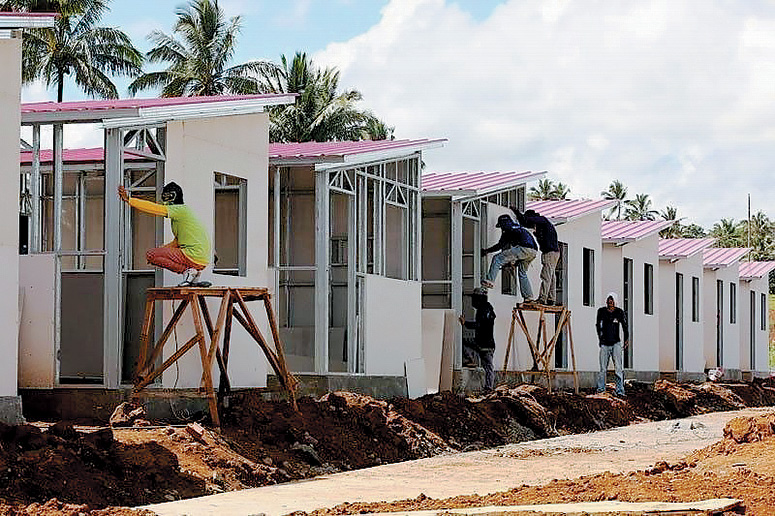The conversation on mass housing is once again in the headlines, amidst efforts to rapidly reactivate this major driver of the economy, on the back of evolving technologies, platforms, and worldwide inflations in the last few years of our post-pandemic reality.
Local developers are working closely with the government to prioritize new efforts to resolve process bottlenecks, price ceilings and benchmarks, define new directions in community planning and service that need updating in order to address new challenges and enhance developers’ capacity to help the government in addressing the housing backlog that continues to grow.
The Department of Human Settlements and Urban Development (DHSUD) and National Economic and Development Authority (NEDA) signed the joint declaration on the adjustment of the price ceiling for economic housing to P2.5 million from P1.7 million last May 11.
The private sector welcomed this move as it had earlier espoused the adjustments in the price ceiling, which needed to be aligned with economic events in the last six years, given substantial increases in costs for all the inputs to production, i.e., land, labor, transport, construction materials, and other costs of doing business.

This is due to increased worldwide economic activities, logistic bottlenecks, currency depreciation, and political events like sanctions on international trade.
Correspondingly, the DHSUD issued Department Order 2022-03 last June 10, 2022. Implementing the adjustment shall apply to new projects to be launched; while for projects with existing licenses to sell, the new price ceiling will be applied to unsold and yet unconstructed economic housing units only.
Socialized housing
In the category of the government-required production of socialized housing by the private developers, the most needed affordable homes for rank-and-file level workers, Subdivision and Housing Developers Association (SHDA) members are requesting the government to also prioritize the review of the price-ceiling adjustment as this accounts for bulk of the housing demand and where the need is greatest.
It is clear that much needs to be done to prevent a ballooning shortage of affordable homes, given the lowered budget allocations for housing through government production, which is a mere P4.9 billion or less than 0.2 percent of the national budget.
This issue has also triggered crises in Hong Kong, several cities in the US, and in many Latin American countries, where despite growing economies, the poor are unable to join the growth of the country because they cannot acquire assets or homes.
Housing backlog
SHDA believes that increasing the price ceiling attracts more developers to produce units under economic and socialized housing, an essential strategy that will help address the housing backlog in the Philippines, which is estimated to reach 6.5 million by 2030.
If neglected, it is expected that the housing need of the Philippines will hit over 22 million by 2040, as per the latest data. To close the gap, the industry needs to greatly increase production beyond the approximate 250,000 houses a year being achieved today.
The housing sector is a great avenue to help us quickly bounce back from the pandemic slump, hand in hand with the government’s Build Build Build Program.
Boosting the industry will also spur countryside economic development, bringing in a more balanced regional distribution of population and regional economic growth and development, and an overall growth in tax base.
The housing sector is an economic pump-primer as it contributes a 3.4 percent output multiplier to the economy, related with some 80 allied industries, involving all sectors, including women, children, vulnerable groups, and health. It generates substantial direct employment with an average of 120 plus man-days for each basic house unit to be constructed, an average of five percent of the country’s total employment can be addressed. Added to this are the indirect employment generated by backroom support, marketing, and salespeople involved in housing activities.
Among the effects of ownership, housing security of tenure is recognized in studies worldwide, especially for the lower segments of society, to improve peace and order as people acquire an asset stake in their community and an improved five to 15 percent better academic performance is achieved by children, needed in the new economy.
Better health is maintained, which leads to lower budgetary requirements for the health sector.
Apart from the indirect benefits brought about by housing, we need to remember that housing is in itself one of the core goals of any government to provide for its people, and is a major source of social stability and a necessary base for other improvements in industries and all activities.
Long road ahead
There is still a long road ahead before the housing industry catches up on its goal of reducing or eliminating this housing backlog.
But as long as there is a strong partnership, cooperation between real-estate developers, housing industry organizations, stakeholders, and government agencies, sharing the same goal to continue creating progressive policies that will benefit the industry and homebuyers, we should be able to help speed up this post-pandemic economic turnaround. We can help our country attain inclusive economic growth, provide each family a decent, inspiring home and community to build life around.
* * *
Aside from being chairman of SHDA, George Siy serves as the president of Convergence Realty and Development Corp. He leads his other companies in food chain, garments retail, and personal care businesses.
In the early 90s, George Siy co-founded Anvil Business Club, and is currently a director of different national chambers of commerce.
